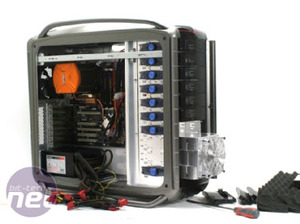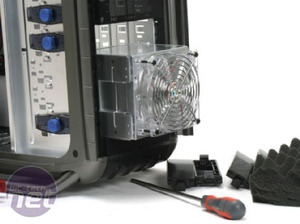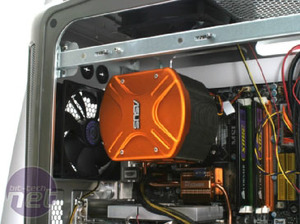
Testing
There are three criteria under which we test any and all cases that come into our hands. These are; ease of installation, noise performance and thermal performance.These are what we reckon to be the most important areas that a PC chassis can perform in. You don’t want a case that’s a pain to install components in because you’d probably go mad just trying to think about the extra effort. Nor do you want a case that will overheat you CPU or drown out your gaming.
To test these criteria we always go through the same testing method. It’s slow, tedious and boring when you consider we could be playing games instead, but somebody has to do it.
To help keep things on a level playing field across all case reviews we use the same hardware each time to test with. Find the details below;
CPU: Intel Pentium XE 955 (dual-core, 3.46GHz)
Graphics Card: Sapphire Radeon X1600 XT Ultimate
Motherboard: MSI P6N SLI Platinum
RAM: 2x 512MB Corsair XMS2-667
Hard Drive: 1x 250GB Western Digital WD2500 7,200RPM
Heatsink: Asus Silent Square Pro
Unfortunately, we ran in to two problems on our very first attempt to install. The first was the hard drive cage that, even when Richard and I both put all our effort into it, was a struggle to shift. We pondered for at least an hour over whether we were doing something wrong or not—we didn't want to break something by forcing it—but it turned out to just be a bit stubborn and the only problem was our stunning lack of muscle.
The next problem we ran into was with the motherboard. Installing the mobo was fine and Cooler Master has done well at designing the Cosmos so that cables can be managed easily and so forth. However, when we flipped the power on, we couldn’t get anything on our display. Nothing. Nada. Zero. Zip.
Richard and I scratched our heads and had a think. We swapped the monitors over. We tried different graphics cards. We tried different cables, different ports and different memory. We even tried a different CPU and a different cooler. Nothing helped. Nada, zero, etc.
So, we took the motherboard out and had a look at it. Rich thought that something in the case may be shorting the motherboard out, so we hooked up the motherboard, but outside the case. It worked fine. We thought Rich was right, so we checked all the stand-offs and so forth and made sure that the case wasn’t interfering with the motherboard.
But, nothing. Still.
In the end we pulled out another motherboard altogether, used the same hardware and the same set-up. With our new motherboard, an MSI P7N SLI Platinum, it worked fine. We decided not to tempt fate and stayed with that motherboard. We had a good long talk about it and couldn’t decide if the problem was an issue with the discarded motherboard or the case itself – in the end we’ve only mentioned it so as to give an honest account of our experience.
Hardware/case problems aside, the Cosmos S turned out to be a very easy case to work with and we didn’t have any problems moving cables aside or getting screws in place. Noise-wise the case was pretty good too and never really drowned out anything that we were listening to.
The only real problem we could pin down as an issue with the case design was the hard drive. Maybe we’re just weak, but the cage was still far too tough to get out and was jammed in so tightly that removing it actually scratched the aluminium covers used to protect and cover the cage.

MSI MPG Velox 100R Chassis Review
October 14 2021 | 15:04












Want to comment? Please log in.